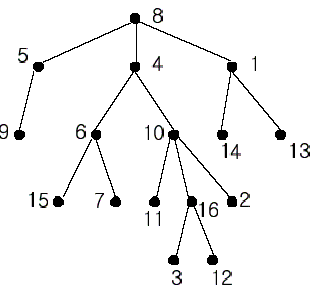poj-1330 Nearest Common Ancestors
Posted cautx
tags:
篇首语:本文由小常识网(cha138.com)小编为大家整理,主要介绍了poj-1330 Nearest Common Ancestors相关的知识,希望对你有一定的参考价值。
Nearest Common Ancestors
| Time Limit: 1000MS | Memory Limit: 10000K | |
| Total Submissions: 39816 | Accepted: 19722 |
Description
A rooted tree is a well-known data structure in computer science and engineering. An example is shown below:

In the figure, each node is labeled with an integer from {1, 2,...,16}. Node 8 is the root of the tree. Node x is an ancestor of node y if node x is in the path between the root and node y. For example, node 4 is an ancestor of node 16. Node 10 is also an ancestor of node 16. As a matter of fact, nodes 8, 4, 10, and 16 are the ancestors of node 16. Remember that a node is an ancestor of itself. Nodes 8, 4, 6, and 7 are the ancestors of node 7. A node x is called a common ancestor of two different nodes y and z if node x is an ancestor of node y and an ancestor of node z. Thus, nodes 8 and 4 are the common ancestors of nodes 16 and 7. A node x is called the nearest common ancestor of nodes y and z if x is a common ancestor of y and z and nearest to y and z among their common ancestors. Hence, the nearest common ancestor of nodes 16 and 7 is node 4. Node 4 is nearer to nodes 16 and 7 than node 8 is.
For other examples, the nearest common ancestor of nodes 2 and 3 is node 10, the nearest common ancestor of nodes 6 and 13 is node 8, and the nearest common ancestor of nodes 4 and 12 is node 4. In the last example, if y is an ancestor of z, then the nearest common ancestor of y and z is y.
Write a program that finds the nearest common ancestor of two distinct nodes in a tree.

In the figure, each node is labeled with an integer from {1, 2,...,16}. Node 8 is the root of the tree. Node x is an ancestor of node y if node x is in the path between the root and node y. For example, node 4 is an ancestor of node 16. Node 10 is also an ancestor of node 16. As a matter of fact, nodes 8, 4, 10, and 16 are the ancestors of node 16. Remember that a node is an ancestor of itself. Nodes 8, 4, 6, and 7 are the ancestors of node 7. A node x is called a common ancestor of two different nodes y and z if node x is an ancestor of node y and an ancestor of node z. Thus, nodes 8 and 4 are the common ancestors of nodes 16 and 7. A node x is called the nearest common ancestor of nodes y and z if x is a common ancestor of y and z and nearest to y and z among their common ancestors. Hence, the nearest common ancestor of nodes 16 and 7 is node 4. Node 4 is nearer to nodes 16 and 7 than node 8 is.
For other examples, the nearest common ancestor of nodes 2 and 3 is node 10, the nearest common ancestor of nodes 6 and 13 is node 8, and the nearest common ancestor of nodes 4 and 12 is node 4. In the last example, if y is an ancestor of z, then the nearest common ancestor of y and z is y.
Write a program that finds the nearest common ancestor of two distinct nodes in a tree.
Input
The
input consists of T test cases. The number of test cases (T) is given in
the first line of the input file. Each test case starts with a line
containing an integer N , the number of nodes in a tree,
2<=N<=10,000. The nodes are labeled with integers 1, 2,..., N.
Each of the next N -1 lines contains a pair of integers that represent
an edge --the first integer is the parent node of the second integer.
Note that a tree with N nodes has exactly N - 1 edges. The last line of
each test case contains two distinct integers whose nearest common
ancestor is to be computed.
Output
Print exactly one line for each test case. The line should contain the integer that is the nearest common ancestor.
Sample Input
2 16 1 14 8 5 10 16 5 9 4 6 8 4 4 10 1 13 6 15 10 11 6 7 10 2 16 3 8 1 16 12 16 7 5 2 3 3 4 3 1 1 5 3 5
Sample Output
4 3
Source
OJ-ID:
poj-1330
author:
Caution_X
date of submission:
20191109
tags:
dfs
description modelling:
给定一棵树(权值∈[1,n]且不重复),给定整数x,y,问x,y的最近公共祖先的值是多少
major steps to solve it:
(1)对x进行dfs,把沿途遍历到的所有节点存入set<int>
(2)对y进行dfs,然后判断y的祖先能否在set<int>里被找到,若被找到,则当前值就是最近祖先的值
AC code:
#include<cstdio> #include<cstring> #include<set> using namespace std; int pre[10005]; set<int> book; void dfsx(int x) { book.insert(x); if(pre[x]!=0) dfsx(pre[x]); } void dfsy(int y) { if(book.find(y)!=book.end()) { printf("%d ",y); return; } if(pre[y]!=0) dfsy(pre[y]); } int main() { int T; scanf("%d",&T); while(T--) { book.clear(); int n; scanf("%d",&n); memset(pre,0,sizeof(pre)); for(int i=0;i<n-1;i++) { int x,y; scanf("%d%d",&x,&y); pre[y]=x; } int x,y; scanf("%d%d",&x,&y); dfsx(x); dfsy(y); } return 0; }
以上是关于poj-1330 Nearest Common Ancestors的主要内容,如果未能解决你的问题,请参考以下文章